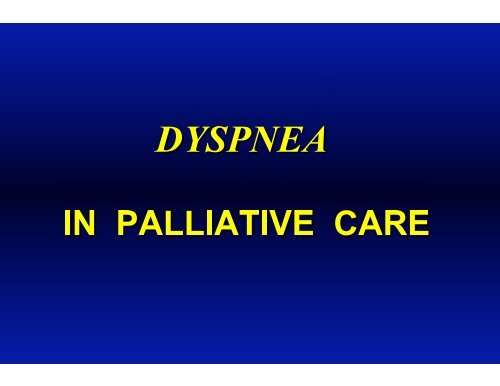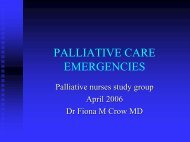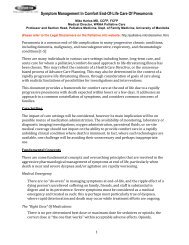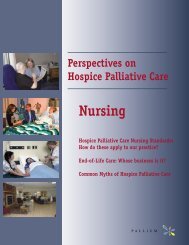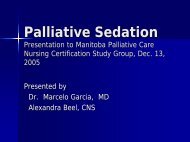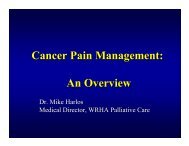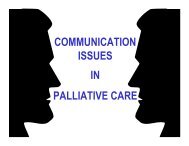Dyspnea - Palliative Care
Dyspnea - Palliative Care
Dyspnea - Palliative Care
You also want an ePaper? Increase the reach of your titles
YUMPU automatically turns print PDFs into web optimized ePapers that Google loves.
National Hospice Study<br />
• n = 1764<br />
• prospective<br />
• Incidence: 70 % during last 6 wks. of life<br />
Reuben DB, Mor V. <strong>Dyspnea</strong> in terminally ill cancer patients.<br />
Chest 1986;89(2):234-6.
National Hospice Study<br />
<strong>Dyspnea</strong> Prevalence<br />
Reuben DB, Mor V. <strong>Dyspnea</strong> in terminally ill cancer patients.<br />
Chest 1986;89(2):234-6.
HOW WELL ARE WE TREATING DYSPNEA IN THE<br />
TERMINALLY ILL<br />
Addington-Hall JM, MacDonald LD, Anderson HR, Freeling P.<br />
Dying from cancer: the views of bereaved family and friends about<br />
the experience of terminally ill patients.<br />
<strong>Palliative</strong> Medicine 1991 5:207-214.<br />
• n = 80 Last week of life<br />
• severe / very severe dyspnea: 50%<br />
less than of these were offered<br />
effective treatment
CAUSES OF DYSPNEA IN PALLIATIVE<br />
CARE<br />
1. Direct tumor effects<br />
2. Indirect tumor effects<br />
3. Treatment-related<br />
4. Unrelated to cancer
DIRECT TUMOR CAUSES<br />
• Parenchymal<br />
• Lymphangitic carcinomatosis<br />
• Obstruction<br />
• Pleural effusion / tumor<br />
• Pericardial effusion<br />
• Superior vena cava obstruction<br />
• Ascites, hepatomegaly<br />
• Tumor microemboli
INDIRECT CANCER CAUSES<br />
• Cachexia<br />
• Mineral & electrolyte imbalances<br />
• Infections<br />
• Anemia<br />
• Pulmonary embolism<br />
• Neurologic paraneoplastic syndromes<br />
• Aspiration
TREATMENT-RELATED CAUSES<br />
OF DYSPNEA<br />
• Surgery<br />
• Radiation pneumonitis / fibrosis<br />
• Chemotherapy-induced pulm. fibrosis (bleomycin)<br />
• Chemotherapy-induced cardiomyopathy<br />
(adriamycin, cyclophosphamide)<br />
• Neutropenic infection
APPROACH TO THE DYSPNEIC<br />
PALLIATIVE PATIENT<br />
Two basic intervention types:<br />
1. Non-specific, symptom-oriented<br />
2. Disease-specific
SIMPLE MEASURES IN<br />
MANAGING DYSPNEA<br />
• calm reassurance<br />
• sitting up / semi-reclined<br />
• open window<br />
• fan
NON-SPECIFIC PHARMACOLOGIC<br />
INTERVENTIONS IN DYSPNEA<br />
• Oxygen - hypoxic and non-hypoxic<br />
• Opioids - complex variety of central effects<br />
• Chlorpromazine - start with 10 mg po q6h<br />
• Benzodiazepines - literature inconsistent but<br />
clinical experience extensive
TREAT THE CAUSE OF DYSPNEA -<br />
IF POSSIBLE AND APPROPRIATE<br />
• Anti-tumor: chemo/radTx, hormone, laser<br />
• Infection<br />
• CHF<br />
• SVCO<br />
• Pleural effusion<br />
• Pulmonary embolism<br />
• Airway obstruction
DISEASE-SPECIFIC MEDICATIONS<br />
FOR DYSPNEA<br />
• Corticosteroids<br />
– obstruction: SVCO, airway<br />
– lymphangitic carcinomatosis<br />
– radiation pneumonitis<br />
• Furosemide<br />
– CHF<br />
– lymphangitic carcinomatosis<br />
• Antibiotics<br />
• Anticoagulation – pulm. embolus<br />
• Bronchodilators
DYSPNEA CRISIS<br />
• Sudden onset / rapid worsening of dyspnea<br />
• Often imminently terminal situation<br />
(minutes or hours)<br />
• Examples:<br />
» pulmonary embolism<br />
» fulminant pneumonia<br />
» upper airway obstruction<br />
» hemoptysis
APPROACH TO DYSPNEA CRISIS<br />
• Aggressively pursue comfort<br />
• Remain on site until comfortable<br />
• Ideally use intravenous route<br />
• Generally employ non-specific measures:<br />
» calm reassurance<br />
» oxygen<br />
» opioids<br />
» possibly sedatives:<br />
– methoptrimeprazine, CPZ, benzodiazepines<br />
(lorazepam, midazolam)
OPIOIDS IN DYSPNEA CRISIS<br />
q10 min. IV push with escalating doses<br />
Example using morphine IV push:<br />
5 - 10 mg<br />
10 - 15 mg<br />
15 - 20 mg<br />
If no better in 10 min.<br />
If no better in 10 min.
CONGESTION IN THE FINAL HOURS<br />
“Death Rattle”<br />
• Positioning<br />
• ANTISECRETORY<br />
Scopolamine 0.3 - 0.6 mg SQ q1h prn<br />
Atropine 0.4 - 0.8 mg SQ q1h prn<br />
Glycopyrrolate 0.2 - 0.4 mg SQ q2h prn<br />
» less likely to cause delirium, sedation<br />
» less effective<br />
• Consider suctioning if secretions are:<br />
– distressing, proximal, accessible<br />
– not responding to antisecretory agents


